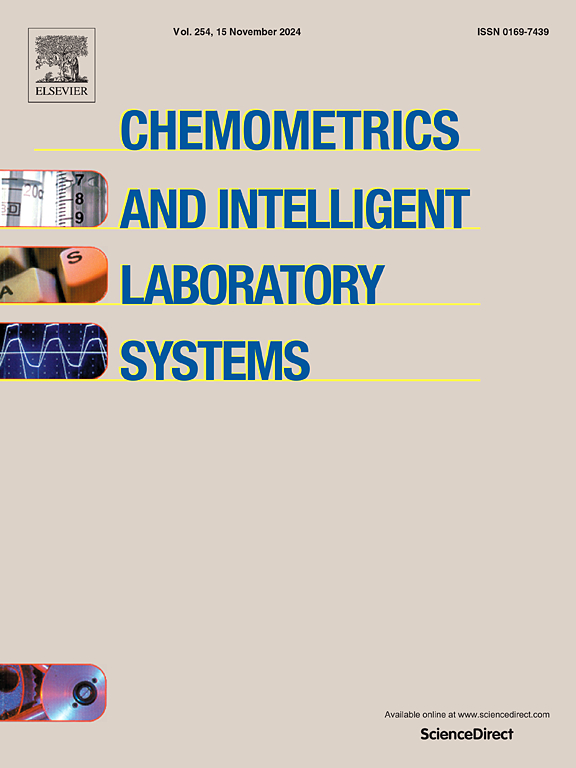Smart portable electronic nose system in combination with machine learning algorithms for the intelligent discrimination of fire debris
IF 3.8
2区 化学
Q2 AUTOMATION & CONTROL SYSTEMS
Chemometrics and Intelligent Laboratory Systems
Pub Date : 2025-06-04
DOI:10.1016/j.chemolab.2025.105459
引用次数: 0
Abstract
The identification and discrimination of ignitable liquid residues (ILRs) in fire debris are crucial in forensic research for determining the intentionality of a fire. This study presents a new method using a portable sensor-based electronic nose (eNose) combined with machine learning (ML) algorithms for automated ILR classification. Six substrates (vinyl, nylon, linoleum, polyester, wood, and cotton) were burned with different ignitable liquids (gasoline, diesel, ethanol, and charcoal starter with kerosene), and samples were collected at intervals from 0 to 48 h after the fire had extinguished. Sensor responses from multiple sensors (SO2, H2S, CO, IRR, NO2, TBM, NH3, and ethanol) were collected over a duration of 140 s. The data were preprocessed using the first derivative and Savitsky-Golay filter, followed by low-level data fusion. A variable selection using the Boruta algorithm was applied, and both reduced and non-reduced matrices were used to train ML models. For detecting the presence of ILRs, random forest (RF) and support vector machine (SVM) models achieved 100 % accuracy. For discriminating between ILR types, the best performance was achieved by the RF model using the reduced matrix, correctly classifying 94.44 % of the samples. Only four sensors (SO2, H2S, CO, IRR) were necessary, indicating the potential for an optimized eNose design. This method offers advantages over traditional techniques, such as faster analysis, lower cost, and greater portability. Additionally, a web application was developed to allow users to automatically characterize fire debris using the algorithms.
结合机器学习算法的智能便携式电子鼻系统用于火灾碎片的智能识别
火灾残骸中可燃液体残余物的鉴定和鉴别是确定火灾故意性的重要法医学研究内容。本研究提出了一种基于便携式传感器的电子鼻(eNose)结合机器学习(ML)算法进行ILR自动分类的新方法。六种基材(乙烯基、尼龙、油毡、聚酯、木材和棉花)用不同的可燃液体(汽油、柴油、乙醇和木炭起火剂用煤油)燃烧,并在火熄灭后的0至48小时内收集样品。收集多个传感器(SO2、H2S、CO、IRR、NO2、TBM、NH3和乙醇)在140 s内的响应。采用一阶导数和Savitsky-Golay滤波对数据进行预处理,然后进行底层数据融合。使用Boruta算法进行变量选择,并使用约简矩阵和非约简矩阵来训练ML模型。对于检测ilr的存在,随机森林(RF)和支持向量机(SVM)模型达到了100%的准确率。对于ILR类型的区分,使用约简矩阵的RF模型表现最佳,正确率为94.44%。仅需要四个传感器(SO2, H2S, CO, IRR),这表明优化eNose设计的潜力。与传统技术相比,这种方法具有优势,例如更快的分析速度、更低的成本和更大的可移植性。此外,开发了一个web应用程序,允许用户使用算法自动描述火灾碎片。
本文章由计算机程序翻译,如有差异,请以英文原文为准。
求助全文
约1分钟内获得全文
求助全文
来源期刊
CiteScore
7.50
自引率
7.70%
发文量
169
审稿时长
3.4 months
期刊介绍:
Chemometrics and Intelligent Laboratory Systems publishes original research papers, short communications, reviews, tutorials and Original Software Publications reporting on development of novel statistical, mathematical, or computer techniques in Chemistry and related disciplines.
Chemometrics is the chemical discipline that uses mathematical and statistical methods to design or select optimal procedures and experiments, and to provide maximum chemical information by analysing chemical data.
The journal deals with the following topics:
1) Development of new statistical, mathematical and chemometrical methods for Chemistry and related fields (Environmental Chemistry, Biochemistry, Toxicology, System Biology, -Omics, etc.)
2) Novel applications of chemometrics to all branches of Chemistry and related fields (typical domains of interest are: process data analysis, experimental design, data mining, signal processing, supervised modelling, decision making, robust statistics, mixture analysis, multivariate calibration etc.) Routine applications of established chemometrical techniques will not be considered.
3) Development of new software that provides novel tools or truly advances the use of chemometrical methods.
4) Well characterized data sets to test performance for the new methods and software.
The journal complies with International Committee of Medical Journal Editors'' Uniform requirements for manuscripts.

 求助内容:
求助内容: 应助结果提醒方式:
应助结果提醒方式:


